Investigation into the Large Deformation Mechanism and Control Technology of Variable Cross-Section Tunnel in Layered Mudstone Stratum
Abstract
:1. Introduction
- To analyze the disaster features, disaster-causing mechanisms and comprehensive reinforcement techniques for a variable cross-section tunnel in layered mudstone stratum combining a field investigation, laboratory tests and numerical simulations;
- To analyze the control effect of reinforcement measures on the deformation and stress response characteristics of surrounding rock for the original and improved supporting structure constructions;
- To evaluate the rationality and effectiveness of the modifications adopted in this study; in addition, the lessons learned are summarized to provide insights to prevent similar incidents from reoccurring in the future.
2. Project Introduction
2.1. Project Overview
2.2. Geology and Hydrological Characteristics
3. Analysis of Cracking Characteristics and Disaster-causing Mechanism
3.1. Cracks Distribution Characteristics
3.2. Disaster-Causing Mechanism Analysis
- (1)
- High Geostress
- (2)
- Surrounding Rock Expansive Property
- (3)
- Layered Joint Structure
- (4)
- Construction Deficiency in Supporting Structure and Lining
3.3. Control Measures
4. Numerical Modeling
4.1. Model Building and Parameters
4.2. Results Analysis
- (1)
- Analysis of Surrounding Rock Deformation
- (2)
- Analysis of Surrounding Rock Stress
- (3)
- Analysis of Secondary Lining Stress
5. Monitoring
5.1. Arrangement of Measuring Points
5.2. Results Analysis
- (1)
- Surrounding Rock Deformation Analysis
- (2)
- Surrounding Rock Stress Analysis
- (3)
- Stress Analysis of Secondary Lining
6. Discussion
7. Conclusions
- (1)
- The developed layered structure, mudstone expansion, the span of the excavation section, the construction methods and an unsuitable supporting structure will all influence the surrounding rock deformation and lining cracking. Meanwhile, the deformation difference of the layered rock on both sides of tunnel was the reason behind the asymmetric distribution of cracks in the secondary lining.
- (2)
- The deformation and stress in the surrounding rock in the broadened section were greater than those in the general section. Additionally, the section span had the most obvious influence on the vault settlement deformation of the surrounding rock. Finally, the convergence deformation and vault settlement in the broadened section were 7.63% and 16.47% higher than those in the general section, and the stress difference was 6.76%.
- (3)
- The deformation and stress in the surrounding rock can be effectively controlled with the improved measures. The maximum deformation and stress in the surrounding rock were reduced by 16.95% and 40.04%, respectively, in comparison to the original construction scheme, and the value of lining stress was 45.35% lower. In particular, the tensile stress area in the secondary lining was transformed into a compressive state, fully utilizing the bearing function of lining structure.
- (4)
- The measured results were consistent with the simulation values for the improved construction scheme. This indicated that by considering the influence of the surrounding rock integrity, section size, excavation method and support strength in a method that combines laboratory experiments, numerical calculations and field monitoring can effectively improve the deformation and stress of tunnel structures, ensuring the safety of tunnel construction and operation.
Author Contributions
Funding
Data Availability Statement
Conflicts of Interest
References
- Du, D.C.; Lei, D.; Liu, K.Q.; Dias, D. Design of quasi-rectangular tunnel built in the rock masses following Hoek-Brown failure criterion. Buildings 2022, 12, 1578. [Google Scholar] [CrossRef]
- Lawongkerd, J.; Shiau, J.; Keawsawasvong, S.; Seehavong, S.; Jamsawang, P. Design equations for predicting stability of unlined horseshoe tunnels in rock masses. Buildings 2022, 12, 1800. [Google Scholar] [CrossRef]
- Fang, Q.; Liu, X.; Zhang, D.L.; Lou, H.C. Shallow tunnel construction with irregular surface topography using cross diaphragm method. Tunn. Undergr. Space Technol. 2017, 68, 11–21. [Google Scholar] [CrossRef]
- Mohsenian, V.; Nikkhoo, A.; Hajirasouliha, I. Estimation of seismic response parameters and capacity of irregular tunnel-form buildings. Bull. Earthq. Eng. 2019, 17, 5217–5239. [Google Scholar] [CrossRef]
- Wang, S.H.; Jierula, A.; Wang, P.Y.; Zhao, Y. Mechanical behaviors of “easy cracking zones” of precast rectangular utility tunnels. Case Stud. Constr. Mater. 2021, 15, e00648. [Google Scholar] [CrossRef]
- He, Y.P.; Sun, X.; Zhang, M.X. Investigation on the deformation of segment linings in cross-fault tunnel considering the creep behavior of surrounding rock during construction-operation period. Buildings 2022, 12, 1648. [Google Scholar] [CrossRef]
- Cheng, Y.; Song, Z.P.; Yang, T.T.; Han, J.J.; Wang, B.W.; Zhang, Z.K. Investigating the aging damage evolution characteristics of layered hard sandstone using digital image correlation. Constr. Build. Mater. 2022, 353, 128838. [Google Scholar] [CrossRef]
- Fan, S.Y.; Song, Z.P.; Zhang, Y.W.; Liu, N.F. Case study of the effect of rainfall infiltration on a tunnel underlying the roadbed slope with weak inter-layer. KSCE J. Civ. Eng. 2020, 24, 1607–1619. [Google Scholar] [CrossRef]
- Fan, S.Y.; Song, Z.P.; Xu, T.; Wang, K.M.; Zhang, Y.W. Tunnel deformation and stress response under the bilateral foundation pit construction-a case study. Arch. Civ. Mech. Eng. 2021, 21, 109. [Google Scholar] [CrossRef]
- Kaya, A.; Karaman, K.; Bulut, F. Geotechnical investigations and remediation design for failure of tunnel portal section: A case study in northern Turkey. J. Mt. Sci. 2017, 14, 1140–1160. [Google Scholar] [CrossRef]
- Tian, X.X.; Song, Z.P.; Zhang, Y.W. Monitoring and reinforcement of landslide induced by tunnel excavation: A case study from Xiamaixi tunnel. Tunn. Undergr. Space Technol. 2021, 110, 103796. [Google Scholar] [CrossRef]
- Shi, X.W.; Feng, X. Numerical assessment of the structural damage of a composite lining water conveyance tunnel subjected to reverse fault conditions. Buildings 2022, 12, 1647. [Google Scholar] [CrossRef]
- Chen, L.; Wu, S.C.; Jin, A.B.; Li, X. The evolution regularity and influence factor analysis of zonal disintegration around deep jointed rock mass: A numerical study based on DEM. Bull. Eng. Geol. Environ. 2022, 81, 37. [Google Scholar] [CrossRef]
- Kou, H.; He, C.; Yang, W.B.; Wu, F.Y.; Zhou, Z.H.; Meng, W.; Xiao, L.G. Asymmetric deformation characteristics and mechanical behavior for tunnels in soft-hard inclined contact strata under high geo-stress: A case study. Bull. Eng. Geol. Environ. 2022, 81, 289. [Google Scholar] [CrossRef]
- Manh, H.T.; Sulem, J.; Subrin, D. A closed-form solution for tunnels with arbitrary cross section excavated in elastic anisotropic ground. Rock Mech. Rock Eng. 2015, 48, 277–288. [Google Scholar] [CrossRef]
- Li, T.; Wang, Y.B.; Yu, Z.W.; Liu, B. Prediction of soil movement and settlement of excavated surface soil of variable section tunnel. J. Cent. South Univ. 2020, 51, 433–444. [Google Scholar]
- Chen, G.; Yu, H.T.; Bobet, A. Analytical solution for seismic response of deep tunnels with arbitrary cross-section shape in saturated orthotropic rock. Rock Mech. Rock Eng. 2022, 55, 5863–5878. [Google Scholar] [CrossRef]
- Qiao, S.F.; Cai, Z.Y. Study on the characteristics of surrounding rock-support in variable cross section construction of Extra-long highway tunnel. Chin. J. Undergr. Space Eng. 2021, 17, 275–282. [Google Scholar]
- Wang, F.; Qian, D.L. Difference solution for a circular tunnel excavated in strain-softening rock mass considering decayed confinement. Tunn. Undergr. Space Technol. 2018, 82, 66–81. [Google Scholar] [CrossRef]
- Liu, N.F.; Li, N.; Xu, C.B.; Li, G.F.; Song, Z.P.; Yang, M. Mechanism of secondary lining cracking and its simulation for the Dugongling tunnel. Rock Mech. Rock Eng. 2020, 53, 4539–4558. [Google Scholar] [CrossRef]
- Zhou, Y.Y.; Xu, D.P.; Liu, K.; Chen, D.F. Understanding the failure mechanism of a large underground cavern in steeply dipping layered rock mass using an enhanced ubiquitous-joint model. Bull. Eng. Geol. Environ. 2021, 80, 4621–4638. [Google Scholar] [CrossRef]
- Hu, S.; Cai, H.B.; Yuan, Z.; Cheng, L.K. Performance comparison test of new sprayed engineered cementitious composites and C25 sprayed concrete. Case Stud. Constr. Mater. 2022, 16, e01139. [Google Scholar] [CrossRef]
- Zhu, M.; Xia, C.Q.; Chen, D.W.; Chen, W.; Hao, K.; Chen, X.S. Influence of grouting sequence on the correction effect of horizontal tunnel displacement by grouting in granite residual soil. Buildings 2022, 12, 1655. [Google Scholar] [CrossRef]
- Cao, Y.; Wu, A.X.; Hou, Y.Q.; Wang, S.Y. Calculation model of shotcrete support thickness based on elastic thin plate theory. Case Stud. Constr. Mater. 2022, 17, e01232. [Google Scholar]
- Feng, X.D.; Jimenez, R.; Zeng, P.; Senent, S. Prediction of time-dependent tunnel convergences using a Bayesian updating approach. Tunn. Undergr. Space Technol. 2019, 94, 103118. [Google Scholar] [CrossRef]
- Yu, K.P.; Ren, F.Y.; Puscasu, R.; Lin, P.; Meng, Q.G. Optimization of combined support in soft-rock roadway. Tunn. Undergr. Space Technol. 2020, 103, 103502. [Google Scholar] [CrossRef]
- Tian, M.L.; Han, L.J.; Yang, X.X.; Feng, Q.; Meng, Q.B.; Xie, Y.Y.; Li, W.S.; Ma, C. Asymmetric deformation failure mechanism and support technology of roadways under non-uniform pressure from a mining disturbance. Bull. Eng. Geol. Environ. 2022, 81, 211. [Google Scholar] [CrossRef]
- Guan, K.; Zhu, W.C.; Wei, J.; Niu, L.L.; Wang, X.R. A finite strain numerical procedure for a circular tunnel in strain-softening rock mass with large deformation. Int. J. Rock Mech. Min. 2018, 112, 266–280. [Google Scholar] [CrossRef]
- Yang, S.Q.; Chen, M.; Fang, G.; Wang, Y.C.; Meng, B.; Li, Y.H.; Jing, H.W. Physical experiment and numerical modelling of tunnel excavation in slanted upper-soft and lower-hard strata. Tunn. Undergr. Space Technol. 2018, 82, 248–264. [Google Scholar] [CrossRef]
- Zhu, Y.M.; Chen, L.; Zhang, H.; Zhou, Z.L.; Chen, S.G. Physical and mechanical characteristics of soft rock tunnel and the effect of excavation on supporting structure. Appl. Sci. 2019, 9, 1517. [Google Scholar] [CrossRef] [Green Version]
- Wang, H.T.; Li, S.C.; Wang, Q.; Wang, D.C.; Li, W.T.; Liu, P.; Li, X.J.; Chen, Y.J. Investigating the supporting effect of rock bolts in varying anchoring methods in a tunnel. Geomech. Eng. 2019, 19, 485–498. [Google Scholar]
- Sun, X.M.; Zhao, C.W.; Tao, Z.G.; Kang, H.K.; He, M.C. Failure mechanism and control technology of large deformation for Muzhailing Tunnel in stratified rock masses. Bull. Eng. Geol. Environ. 2021, 80, 4731–4750. [Google Scholar] [CrossRef]
- Li, Y.Y.; Jin, X.G.; Lv, Z.T.; Dong, J.G.; Guo, J.C. Deformation and mechanical characteristics of tunnel lining in tunnel intersection between subway station tunnel and construction tunnel. Tunn. Undergr. Space Technol. 2016, 56, 22–33. [Google Scholar] [CrossRef]
- Yang, J.P.; Chen, W.Z.; Zhao, W.S.; Tan, X.J.; Tian, H.M.; Yang, D.S.; Ma, C.S. Geohazards of tunnel excavation in interbedded layers under high in situ stress. Eng. Geol. 2017, 230, 11–22. [Google Scholar] [CrossRef]
- Zhang, Q.G.; Fan, X.Y.; Chen, P.; Ma, T.S.; Zeng, F.T. Geomechanical behaviors of shale after water absorption considering the combined effect of anisotropy and hydration. Eng. Geol. 2020, 269, 105547. [Google Scholar] [CrossRef]
- Zhu, H.B.; Fu, Z.H.; Yu, F.; Li, S. Study on deterioration characteristics of uniaxial compression performance and microstructure changes of red-bed mudstone during gaseous water sorption. Buildings 2022, 12, 1399. [Google Scholar] [CrossRef]
- Zhao, H.B.; Zhang, L.; Ren, J.L.; Wang, M.; Meng, Z.Q. AdaBoost-based back analysis for determining rock mass mechanical parameters of claystones in goupitan tunnel, China. Buildings 2022, 12, 1073. [Google Scholar] [CrossRef]
- Fransson, A.; Viola, G. Bentonite rock interaction experiment: A hydro-structural-mechanical approach. Eng. Geol. 2021, 281, 105985. [Google Scholar] [CrossRef]
- Ding, X.L.; Niu, X.Q.; Pei, Q.T.; Huang, S.L.; Zhang, Y.T.; Zhang, C.H. Stability of large underground caverns excavated in layered rock masses with steep dip angles: A case study. Bull. Eng. Geol. Environ. 2019, 78, 5101–5133. [Google Scholar] [CrossRef]
- Xu, D.P.; Feng, X.T.; Chen, D.F.; Zhang, C.Q.; Fan, Q.X. Constitutive representation and damage degree index for the layered rock mass excavation response in underground openings. Tunn. Undergr. Space Technol. 2017, 64, 133–145. [Google Scholar] [CrossRef]
- Zhou, Y.Y.; Xu, D.P.; Gu, G.K.; Liu, K.; Wan, L.P.; Wang, T.L.; Yang, J.B. The failure mechanism and construction practice of large underground caverns in steeply dipping layered rock masses. Eng. Geol. 2019, 250, 45–64. [Google Scholar] [CrossRef]
- Zheng, W.X.; Guo, Y.J.; Zhi, G.J.; Bao, X.K.; Sun, M.; Ren, R.P.; Duan, Z.J.; Gao, Z.D. Stability analysis and control measures of large-span open-off cut with argillaceous cemented sandstone layered roof. Math. Probl. Eng. 2021, 2021, 8744081. [Google Scholar] [CrossRef]
- Komu, M.P.; Guney, U.; Kilickaya, T.E.; Gokceoglu, C. Using 3d numerical analysis for the assessment of tunnel-landslide relationship: Bahce-nurdag tunnel (south of turkey). Geotech. Geol. Eng. 2020, 38, 1237–1254. [Google Scholar] [CrossRef]
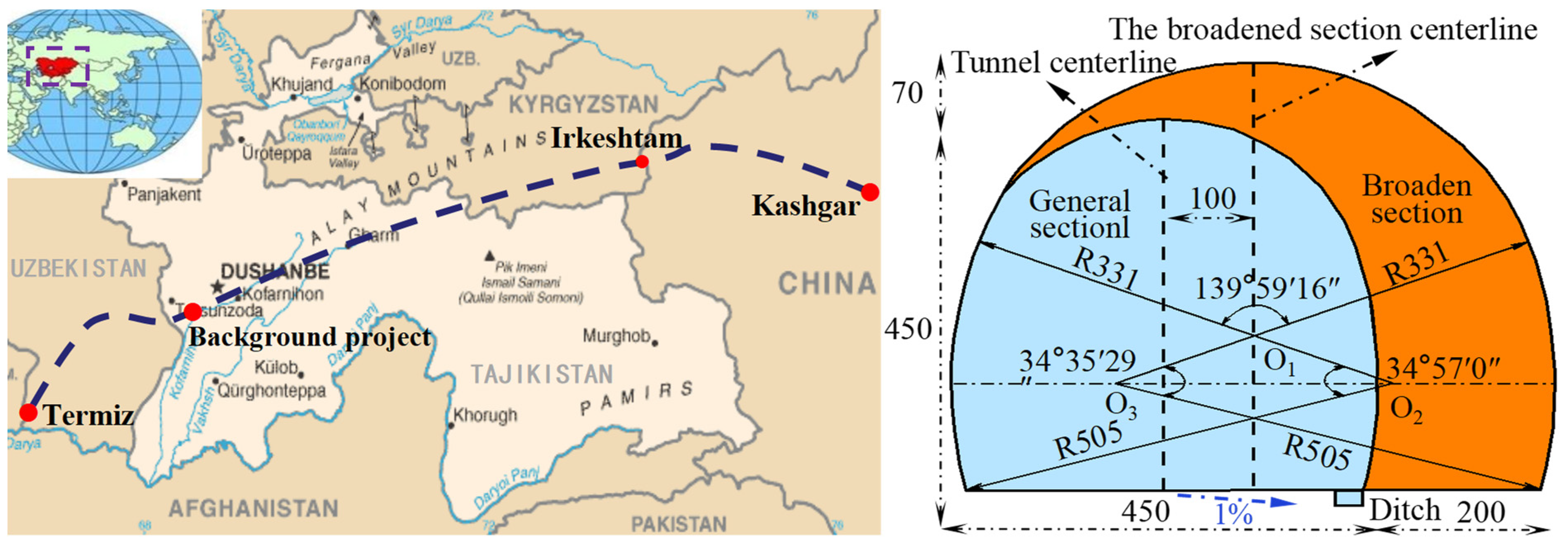


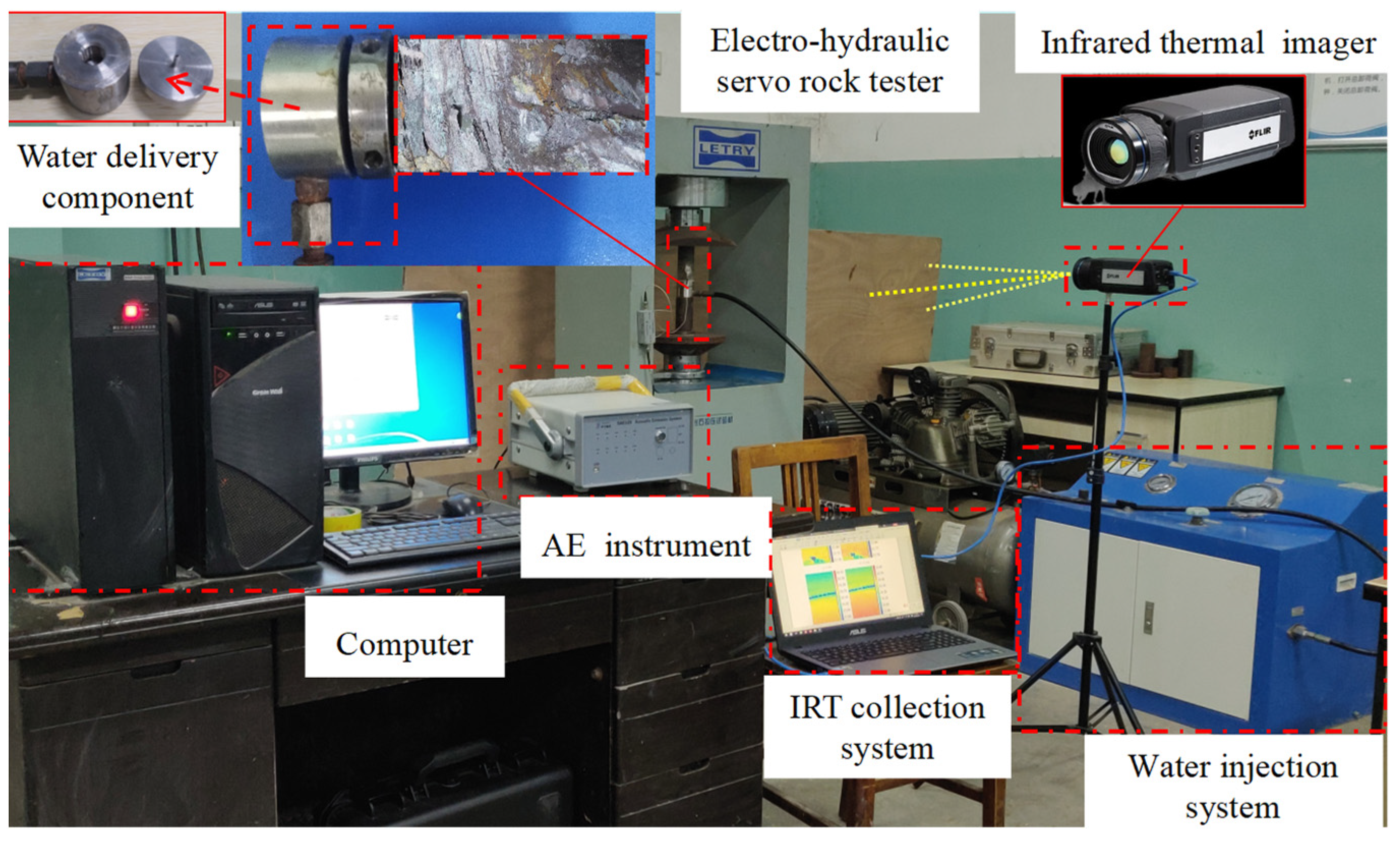
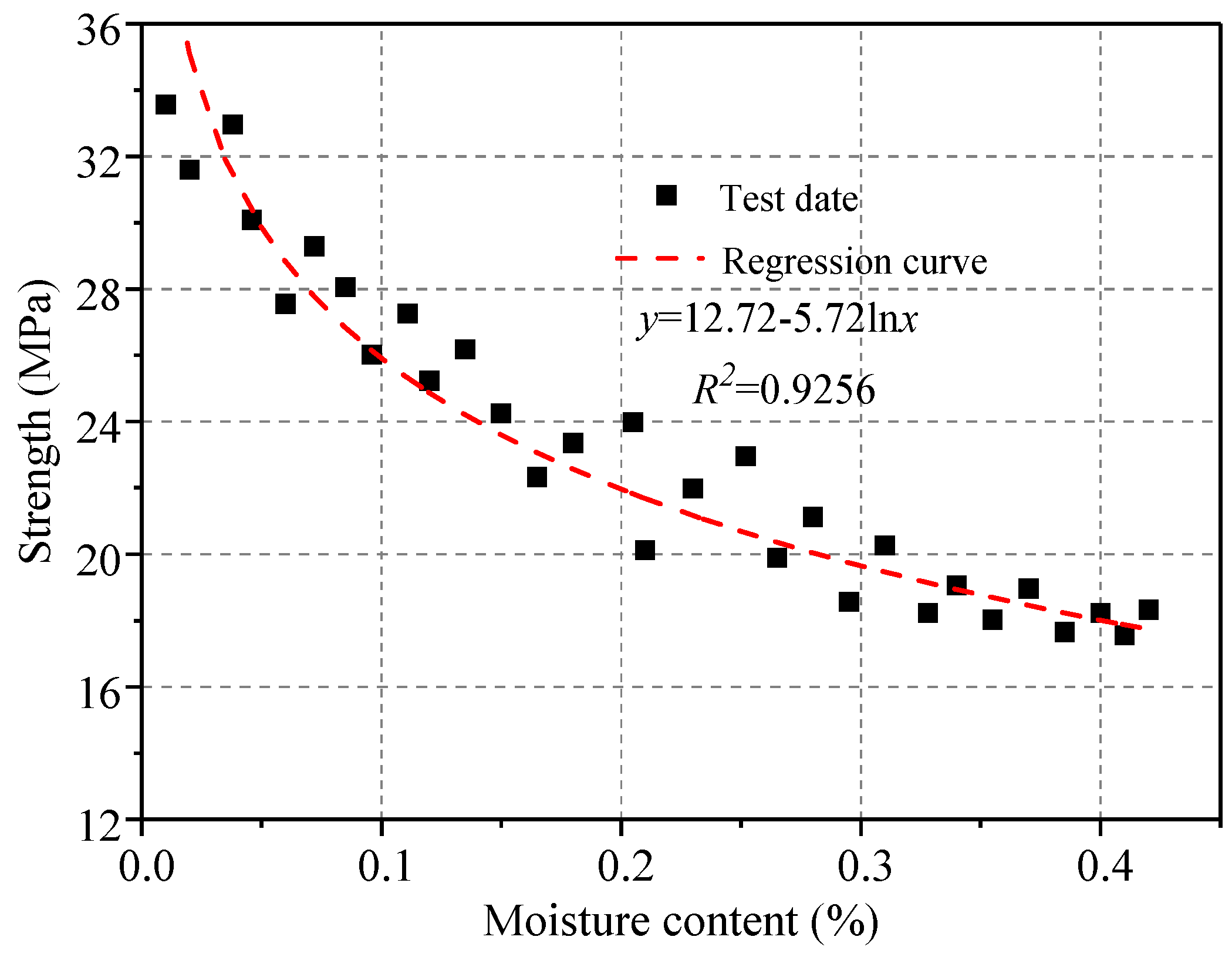


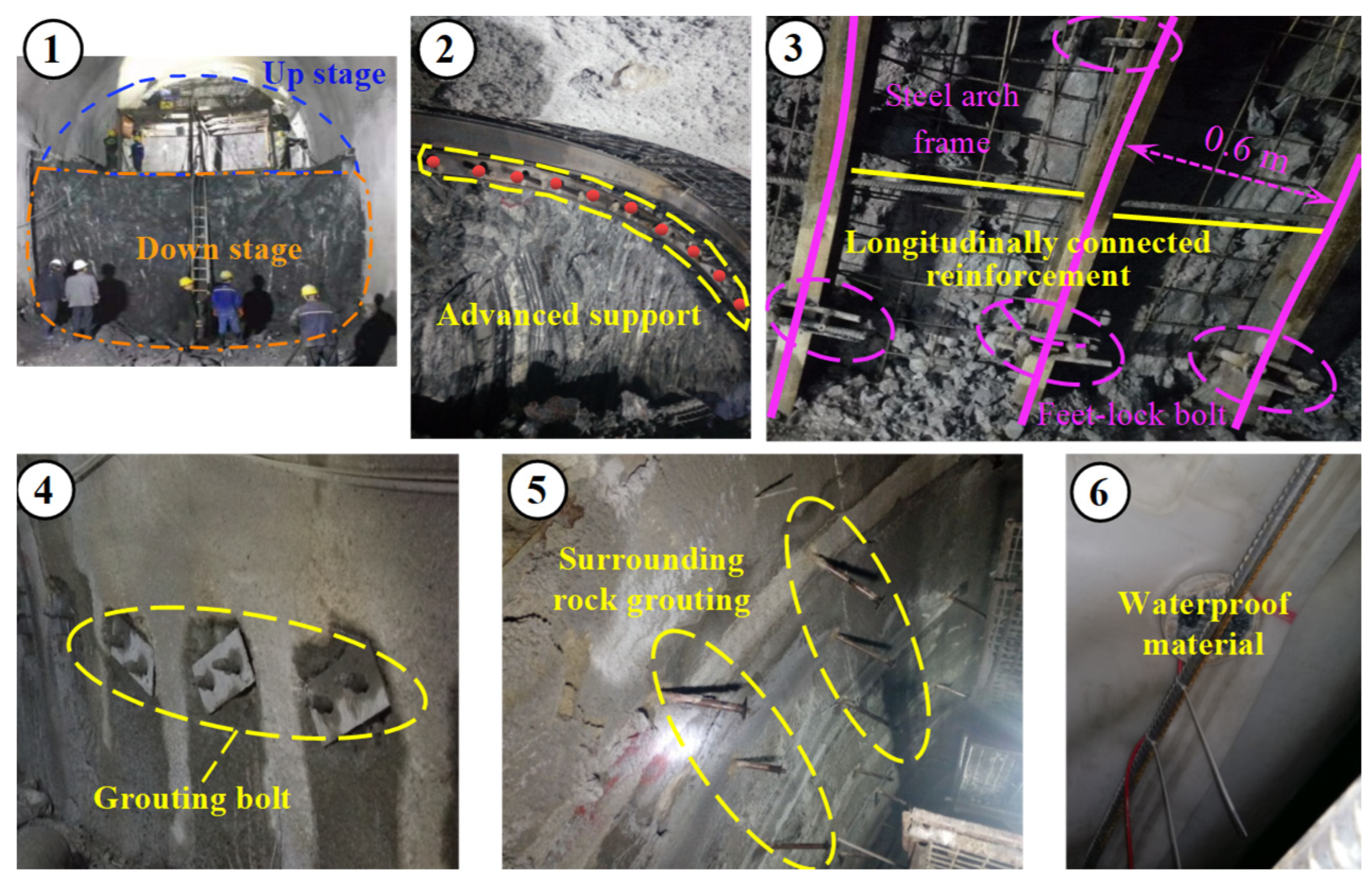
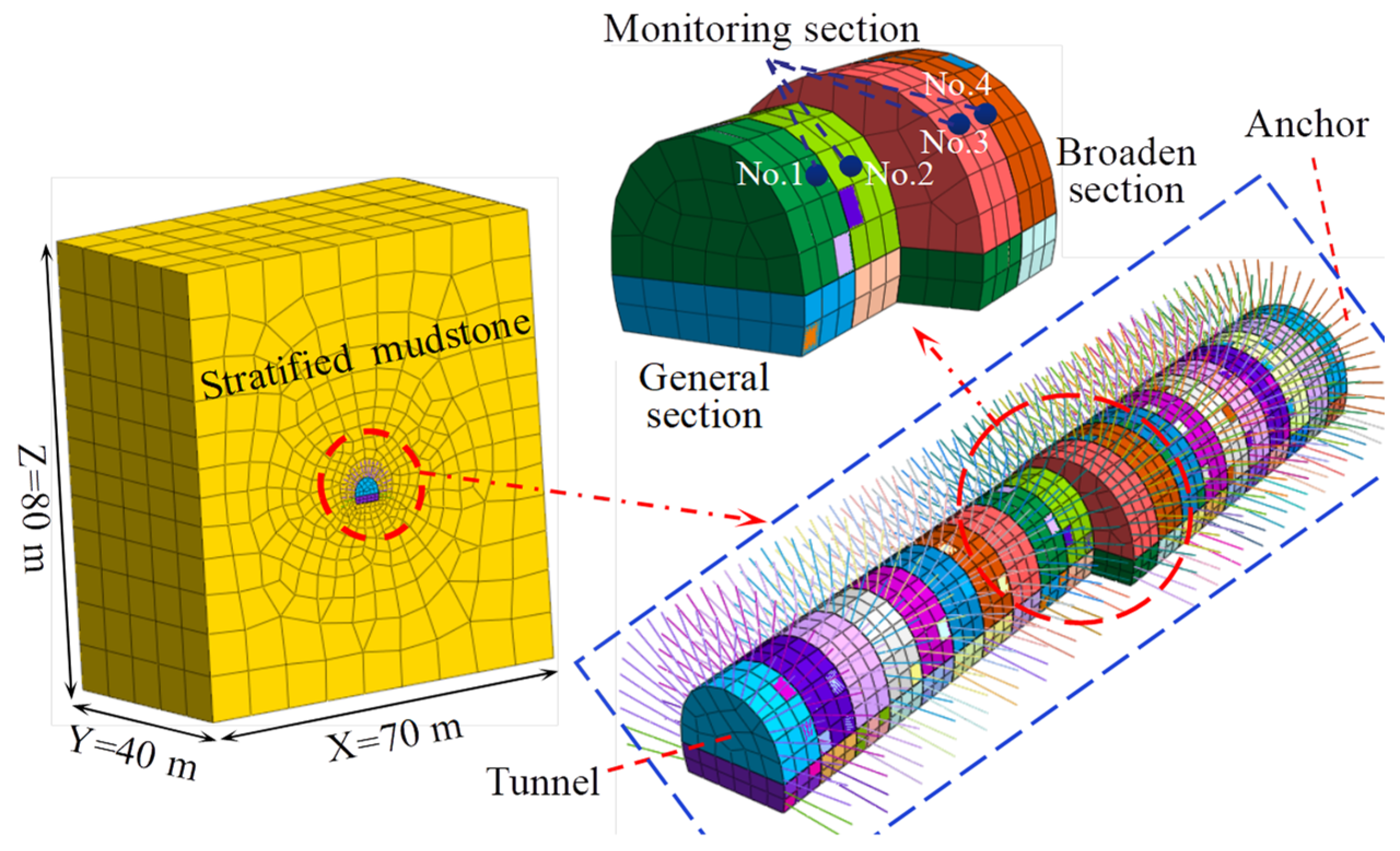
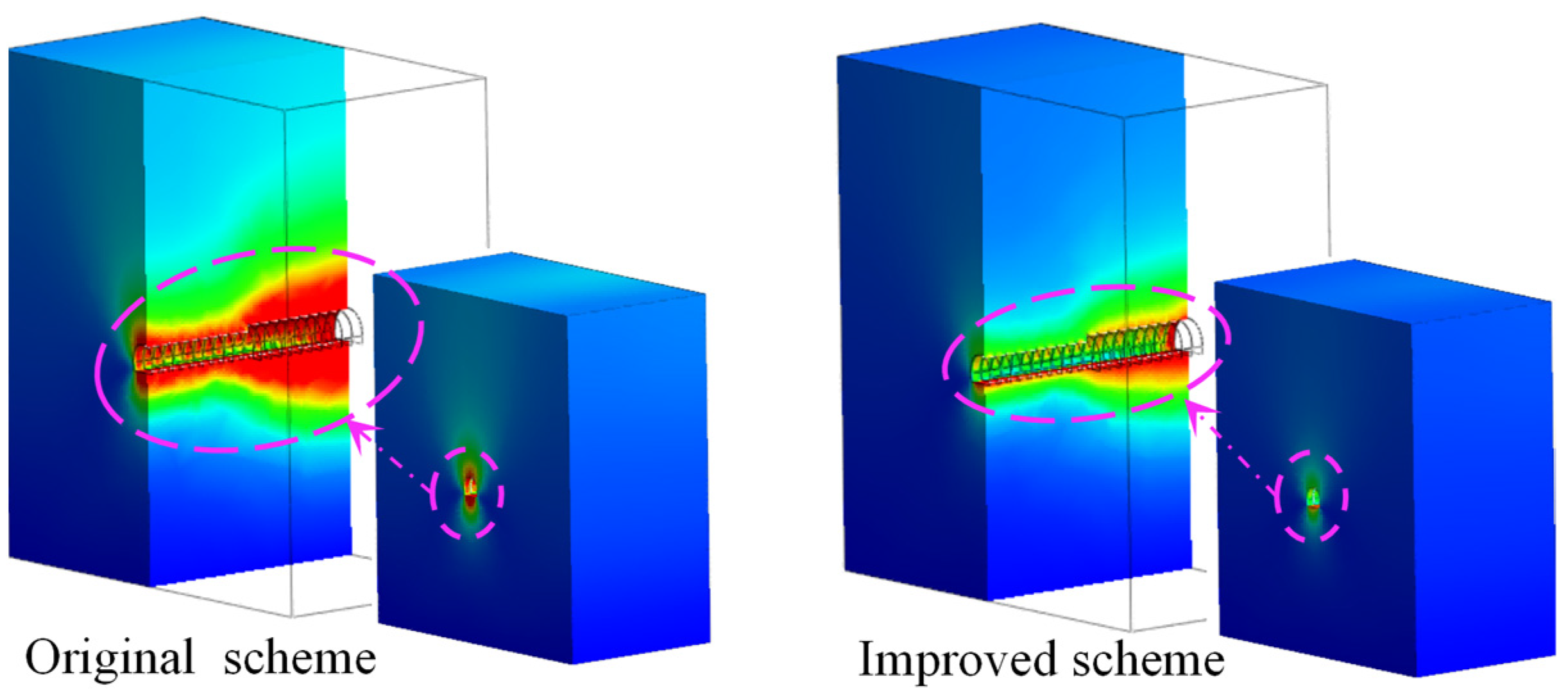
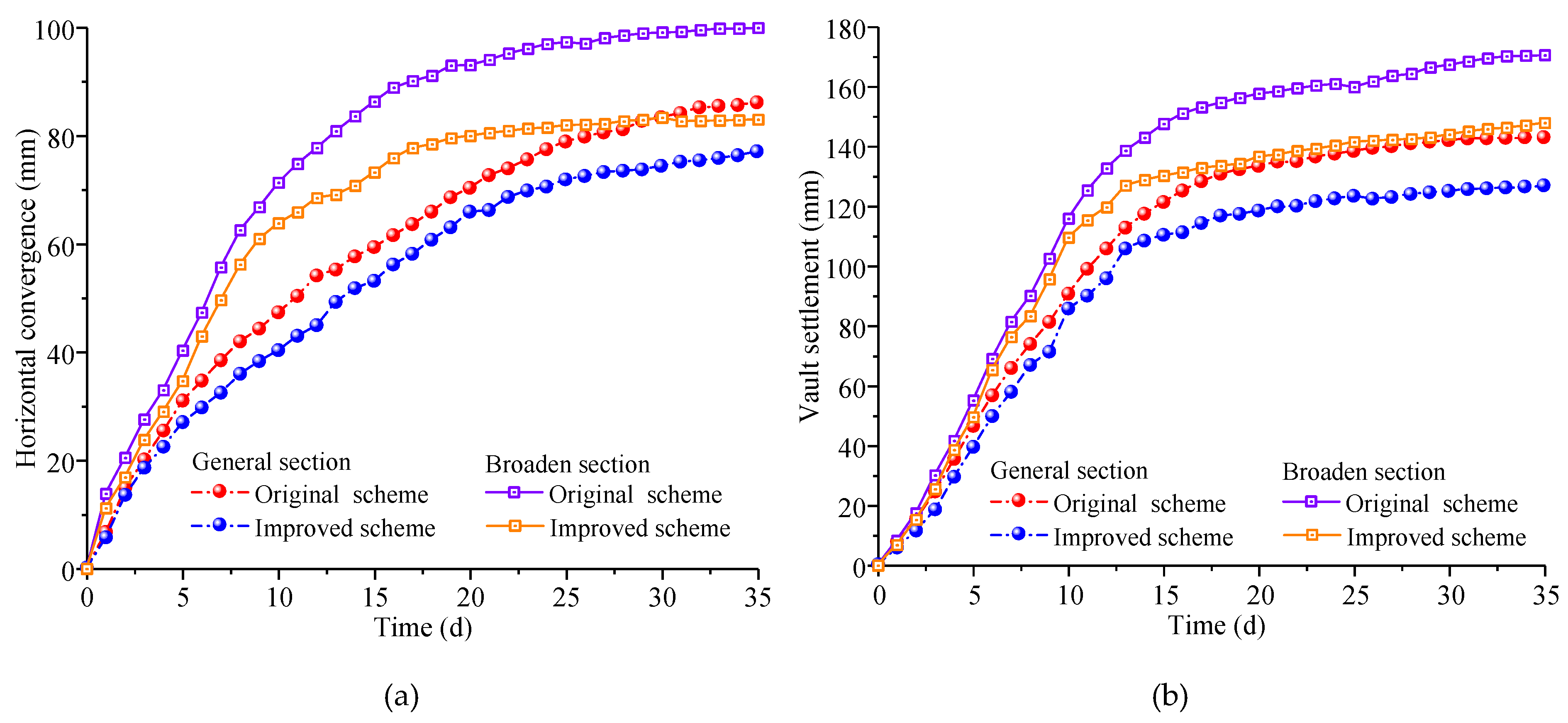
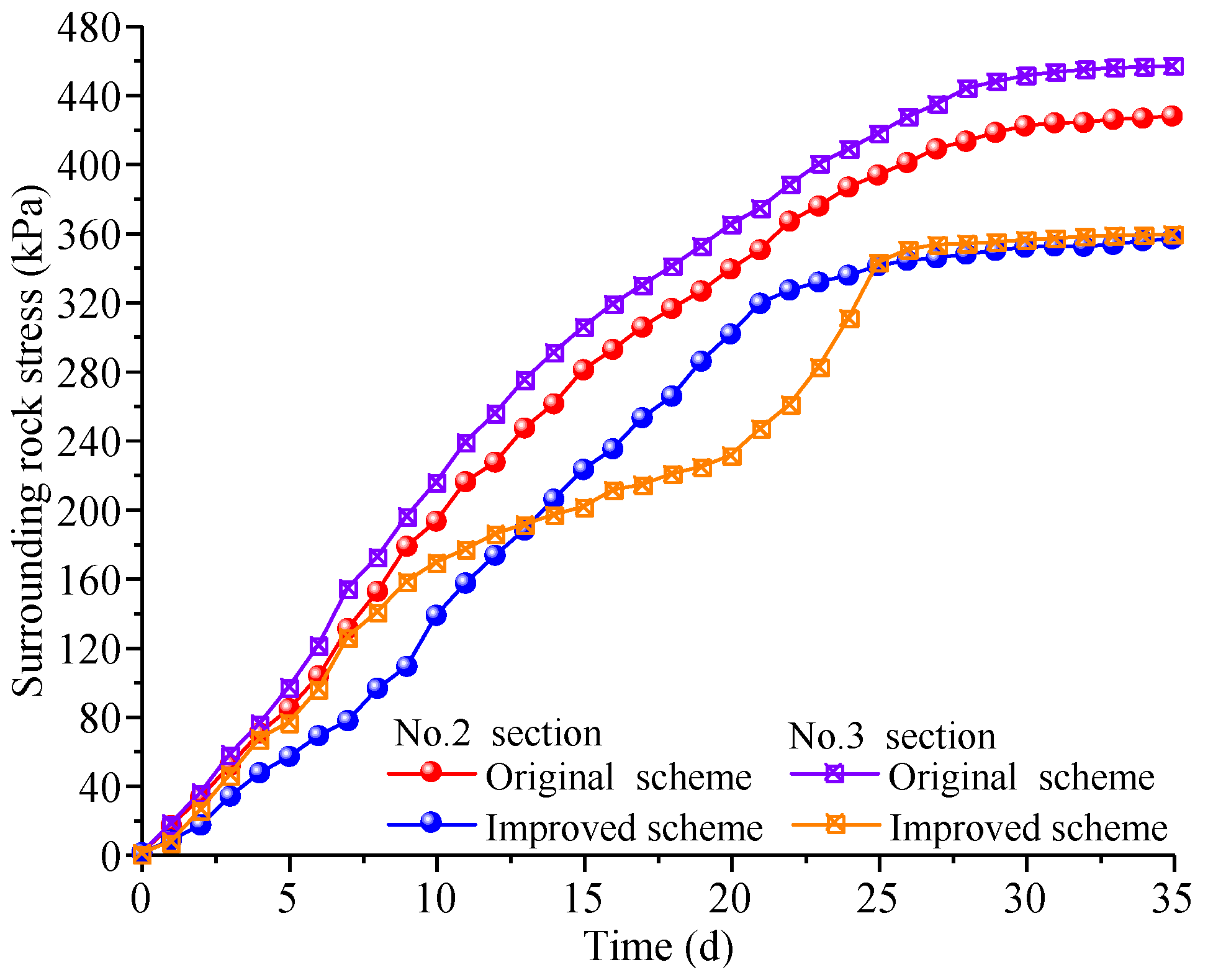
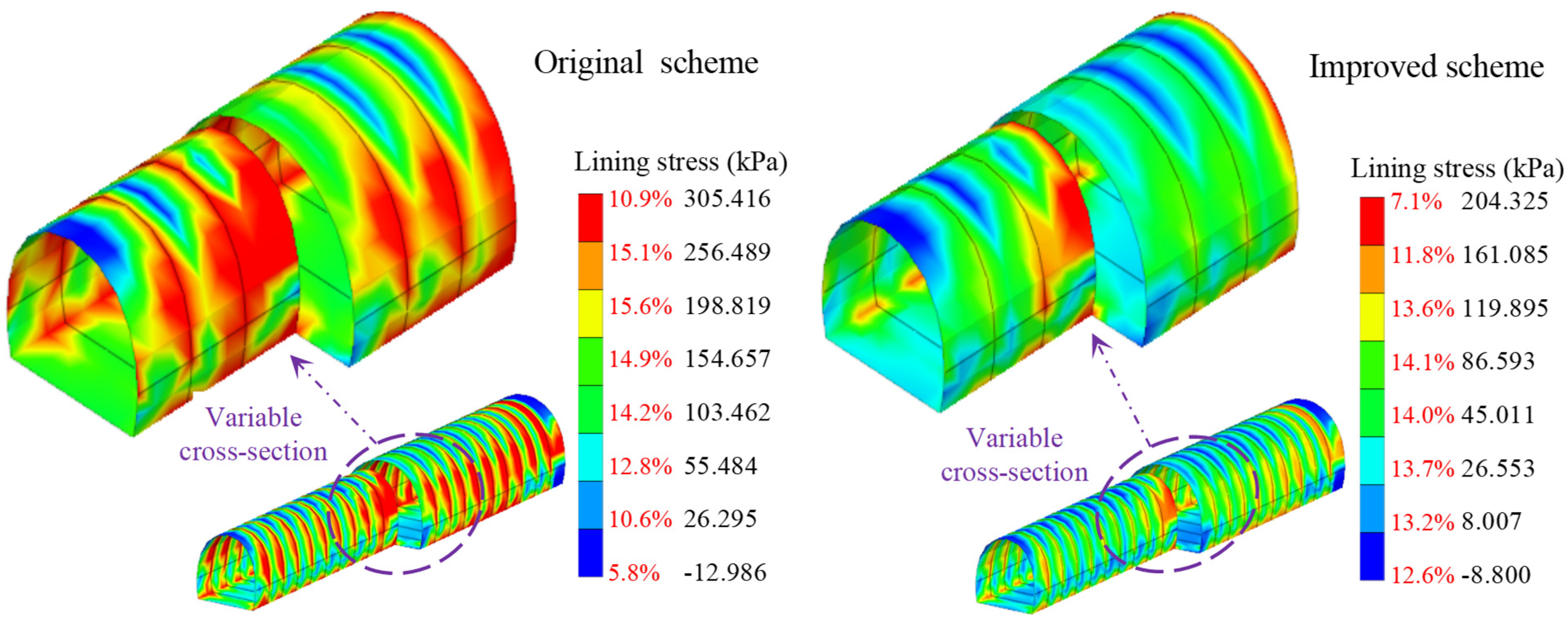

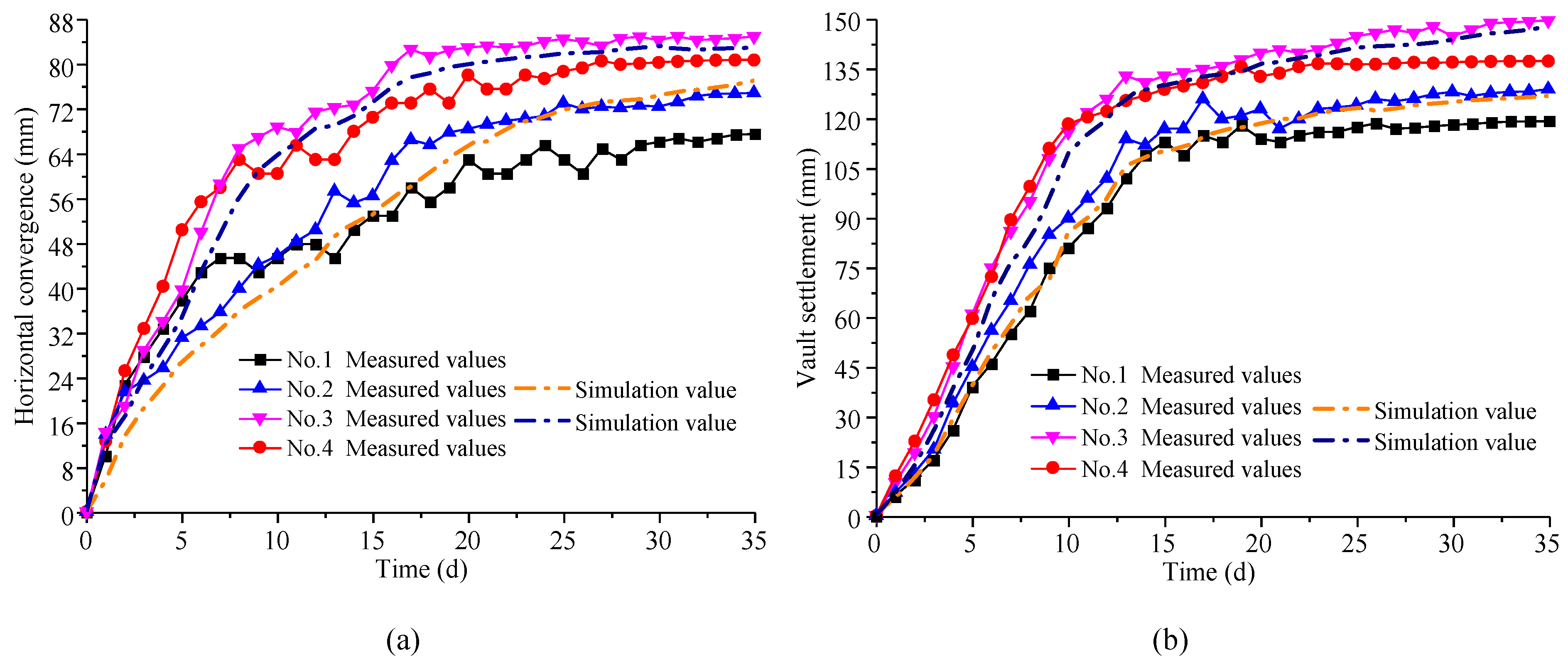
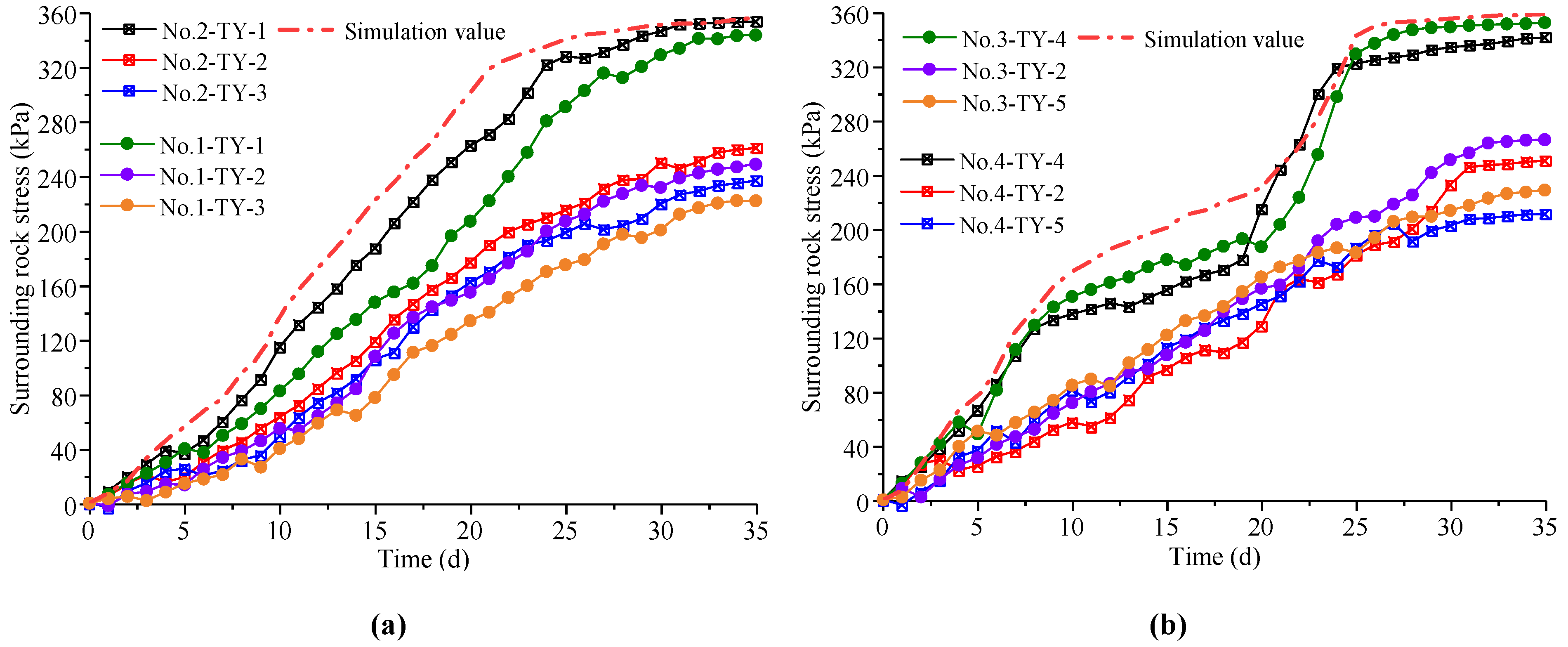
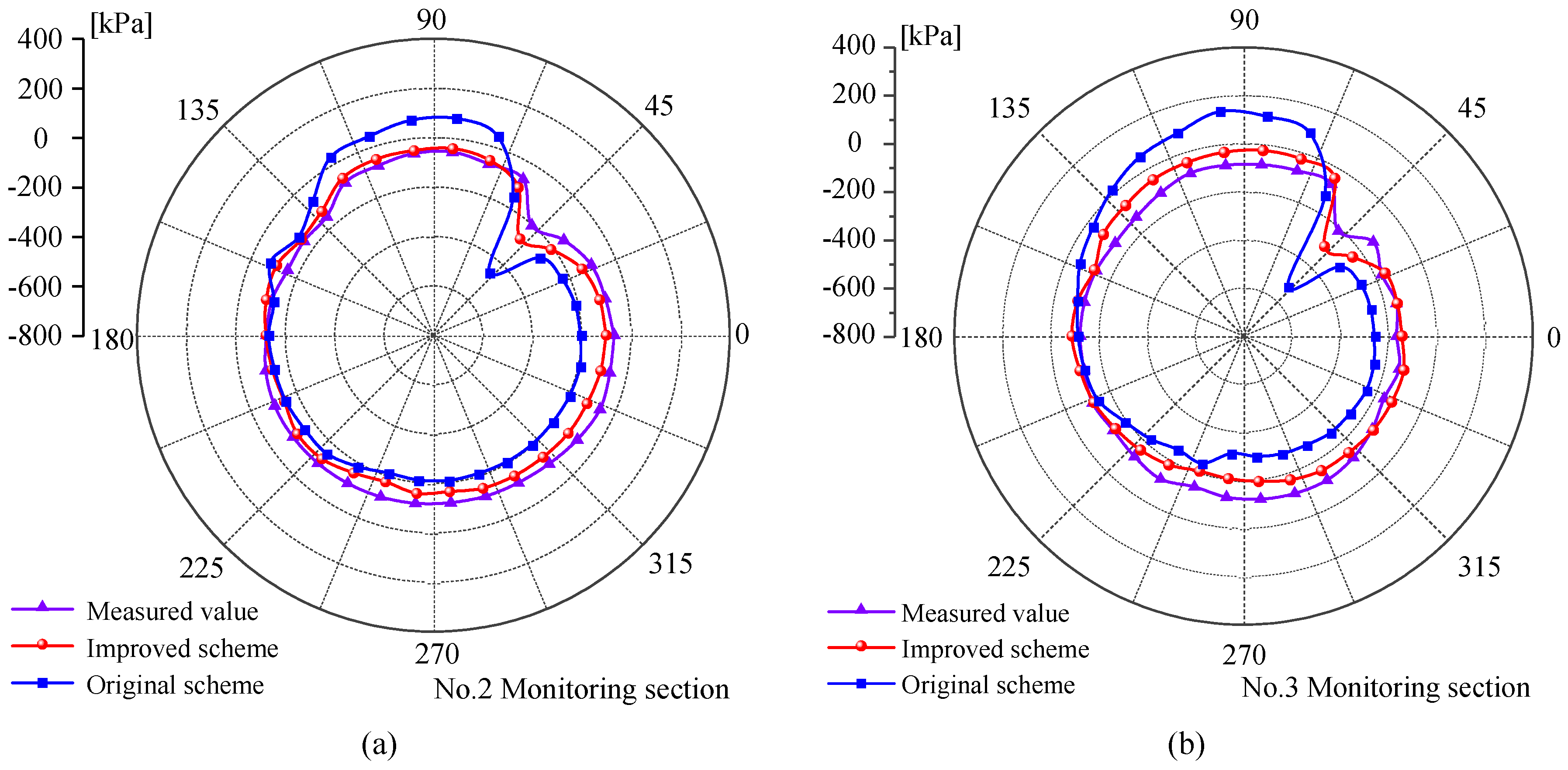
| Soil Layer | E (MPa) | γ (kN/m3) | μ | c (kPa) | ϕ (°) |
|---|---|---|---|---|---|
| Residual slope deposit | 2.52 | 17.5 | 0.18 | 12 | 20 |
| Silty clay | 3.21 | 19 | 0.35 | 18 | 22 |
| Mudstone | 485.96 | 23 | 0.26 | 112 | 25 |
| Rock Core | Clay Minerals (%) | Content | Detrital Minerals Content (%) | Dilatability | ||||||
|---|---|---|---|---|---|---|---|---|---|---|
| Montmorillonite | Illite | Chlorite | Kaolinite | Quartz | Dolomite | Calcite | Zeolite | |||
| L1 | 5 | 35 | 8 | 12 | 60 | 20 | 5 | 3 | 2 | 8.96% |
| L2 | 6 | 32 | 10 | 10 | 58 | 22 | 6 | 9 | 1 | 6.59% |
| R1 | 3 | 26 | 4 | 6 | 39 | 35 | 5 | 10 | 2 | 4.27% |
| R2 | 2 | 29 | 4 | 5 | 40 | 32 | 4 | 12 | 3 | 4.56% |
| No. | Tendency (°) | Inclination (°) | Thick (m) | Average Length (m) |
|---|---|---|---|---|
| 1 | 220 | 78 | 0.5 | 4 |
| 2 | 310 | 58 | 0.5 | 6 |
| Blocks | Interface | ||||
|---|---|---|---|---|---|
| E (GPa) | γ (kN/m3) | μ | c (kPa) | ϕ (°) | σt (MPa) |
| 5 | 23 | 0.26 | 10 | 28 | 0.002 |
| Material | Unit Type | E (GPa) | γ (kN/m3) | μ |
|---|---|---|---|---|
| Anchor | Truss unit | 210 | 78.5 | 0.3 |
| Initial support | Board unit | 29.5 | 23 | 0.2 |
| Steel arch | Board unit | 200 | 78.5 | 0.3 |
| Secondary lining | Board unit | 30 | 25 | 0.25 |
| Grouting reinforcement | Physical unit | 35.5 | 26.3 | 0.34 |
Disclaimer/Publisher’s Note: The statements, opinions and data contained in all publications are solely those of the individual author(s) and contributor(s) and not of MDPI and/or the editor(s). MDPI and/or the editor(s) disclaim responsibility for any injury to people or property resulting from any ideas, methods, instructions or products referred to in the content. |
© 2022 by the authors. Licensee MDPI, Basel, Switzerland. This article is an open access article distributed under the terms and conditions of the Creative Commons Attribution (CC BY) license (https://creativecommons.org/licenses/by/4.0/).
Share and Cite
Fan, S.; Song, Z.; Li, X.; Zhang, Y.; Liu, L. Investigation into the Large Deformation Mechanism and Control Technology of Variable Cross-Section Tunnel in Layered Mudstone Stratum. Buildings 2023, 13, 110. https://doi.org/10.3390/buildings13010110
Fan S, Song Z, Li X, Zhang Y, Liu L. Investigation into the Large Deformation Mechanism and Control Technology of Variable Cross-Section Tunnel in Layered Mudstone Stratum. Buildings. 2023; 13(1):110. https://doi.org/10.3390/buildings13010110
Chicago/Turabian StyleFan, Shengyuan, Zhanping Song, Xu Li, Yuwei Zhang, and Lianbaichao Liu. 2023. "Investigation into the Large Deformation Mechanism and Control Technology of Variable Cross-Section Tunnel in Layered Mudstone Stratum" Buildings 13, no. 1: 110. https://doi.org/10.3390/buildings13010110






